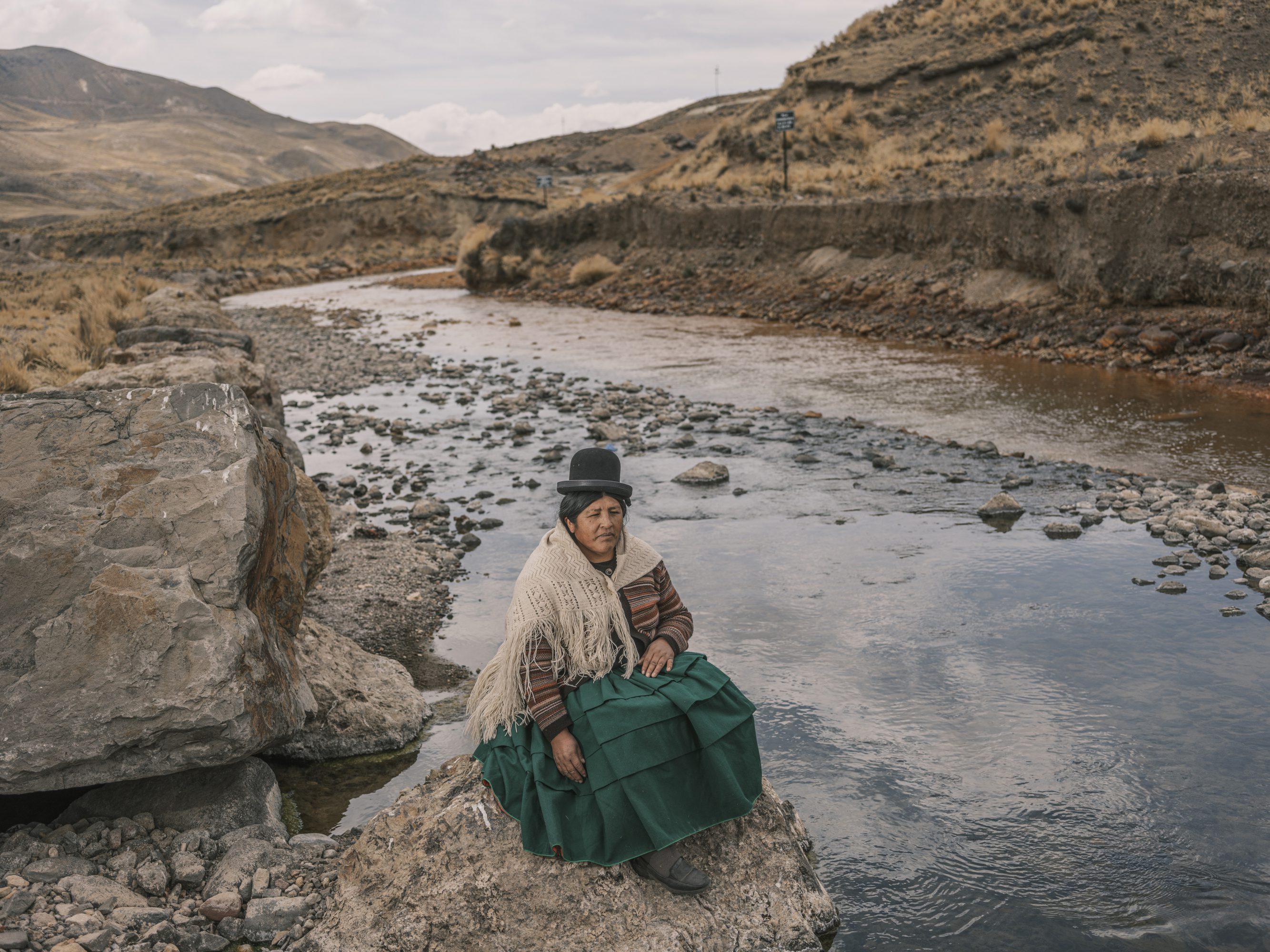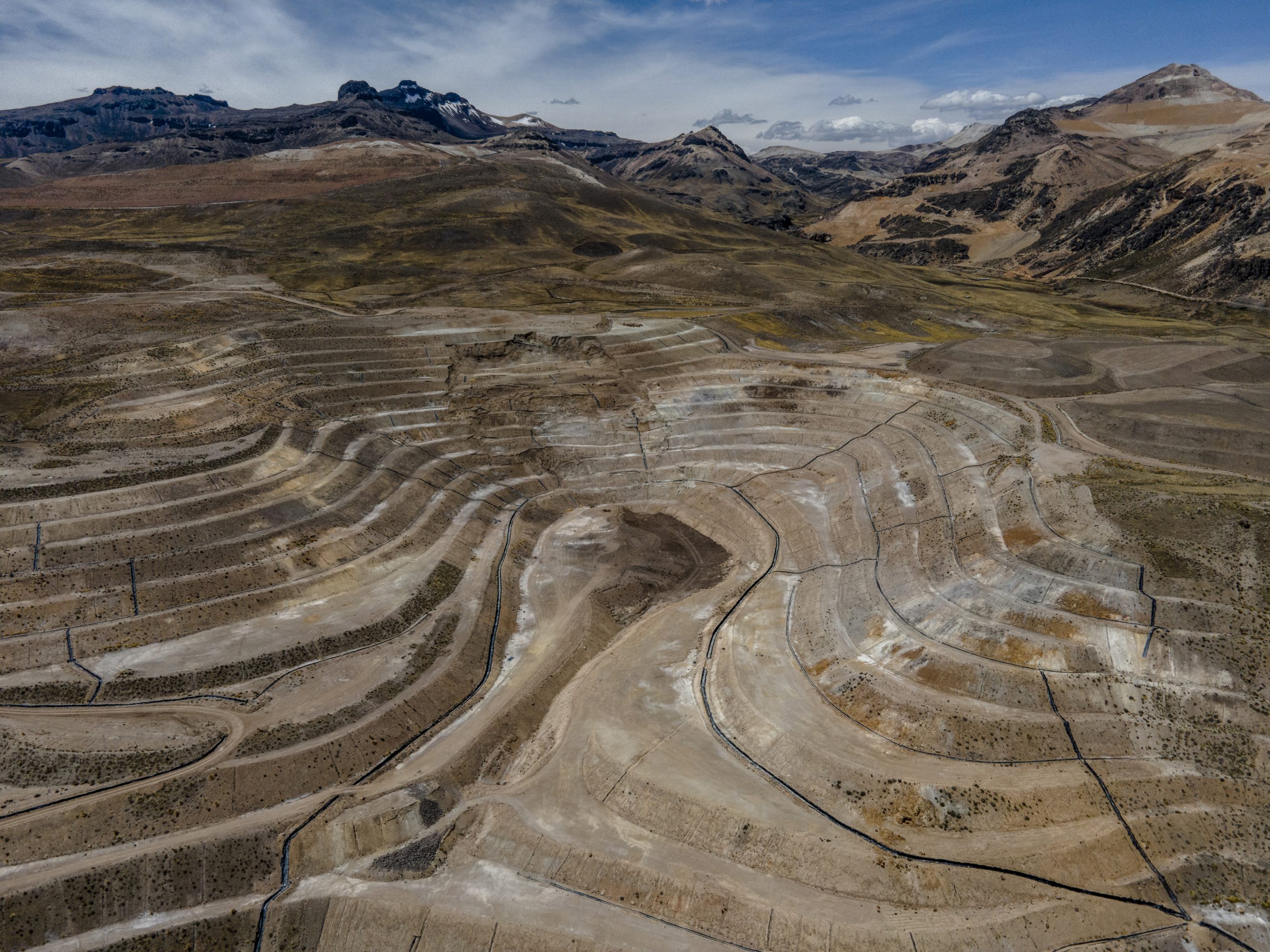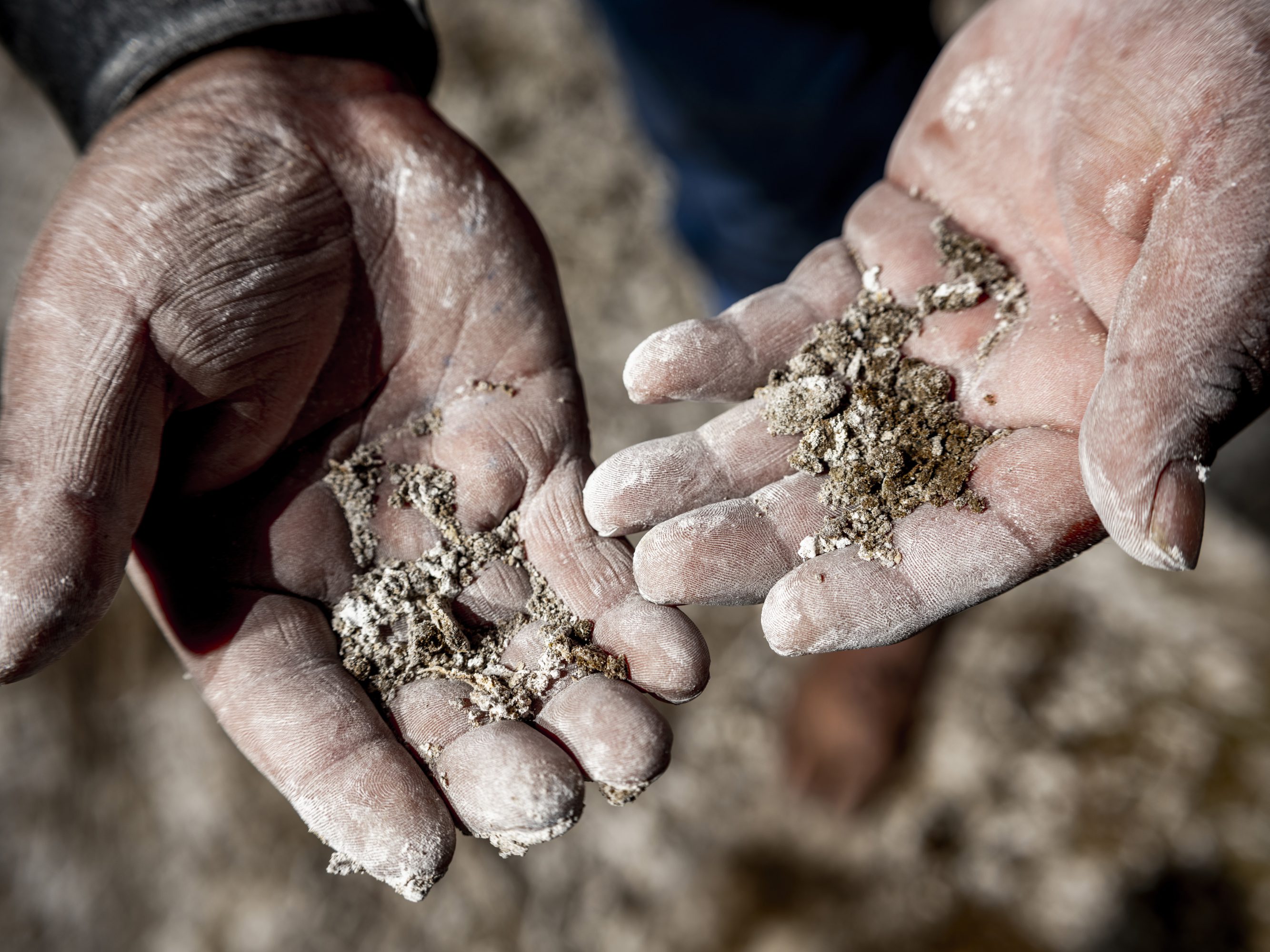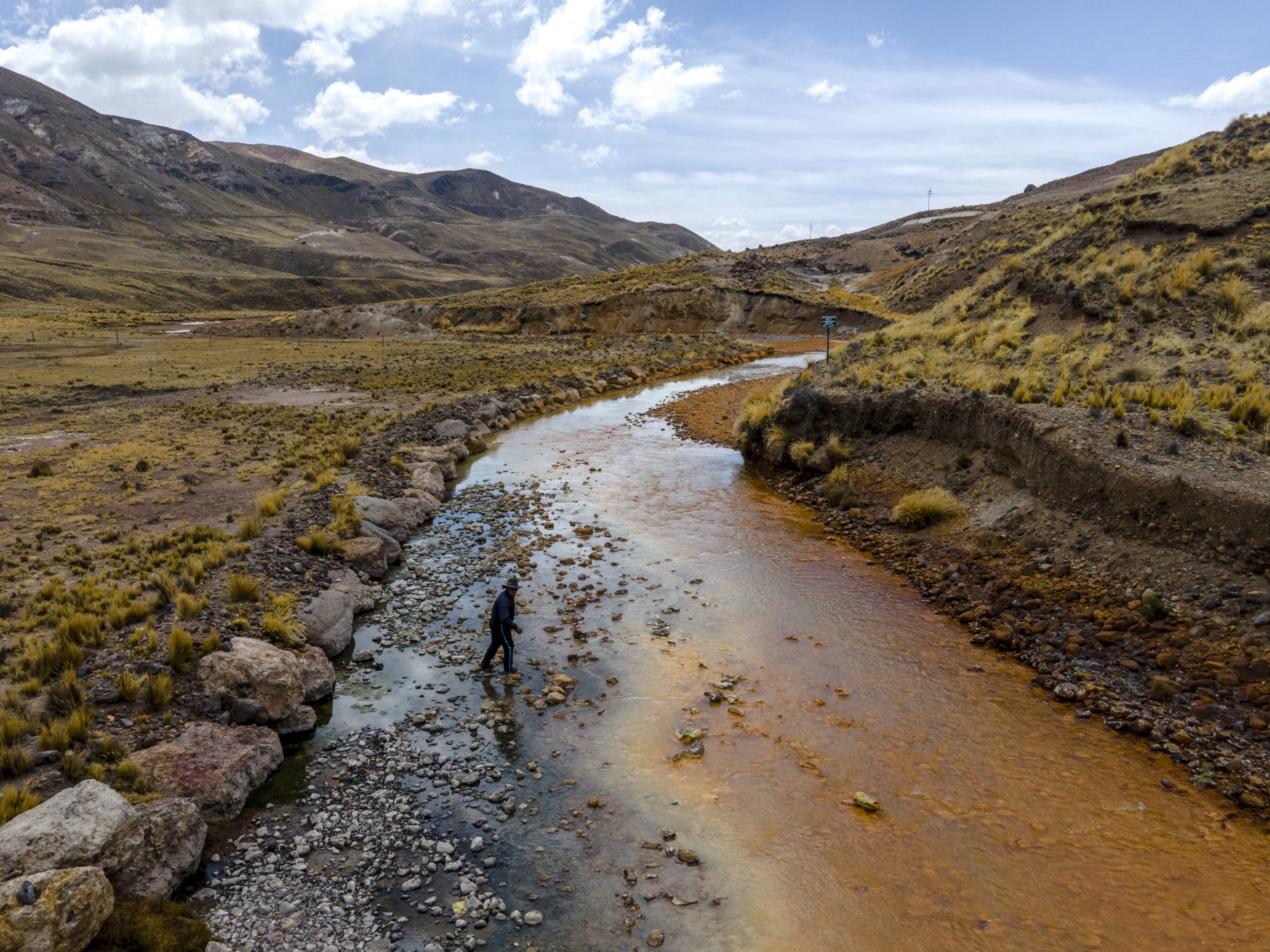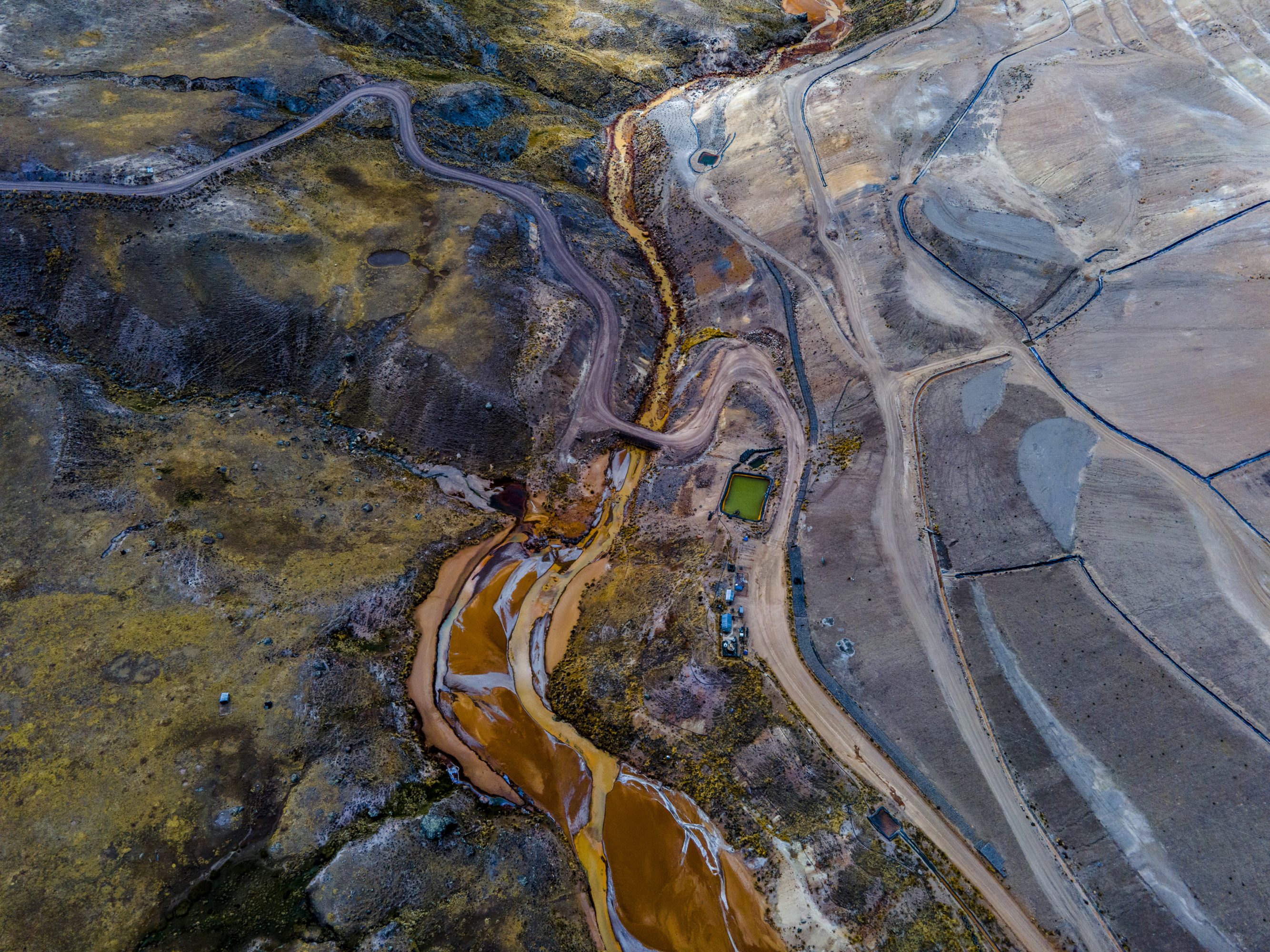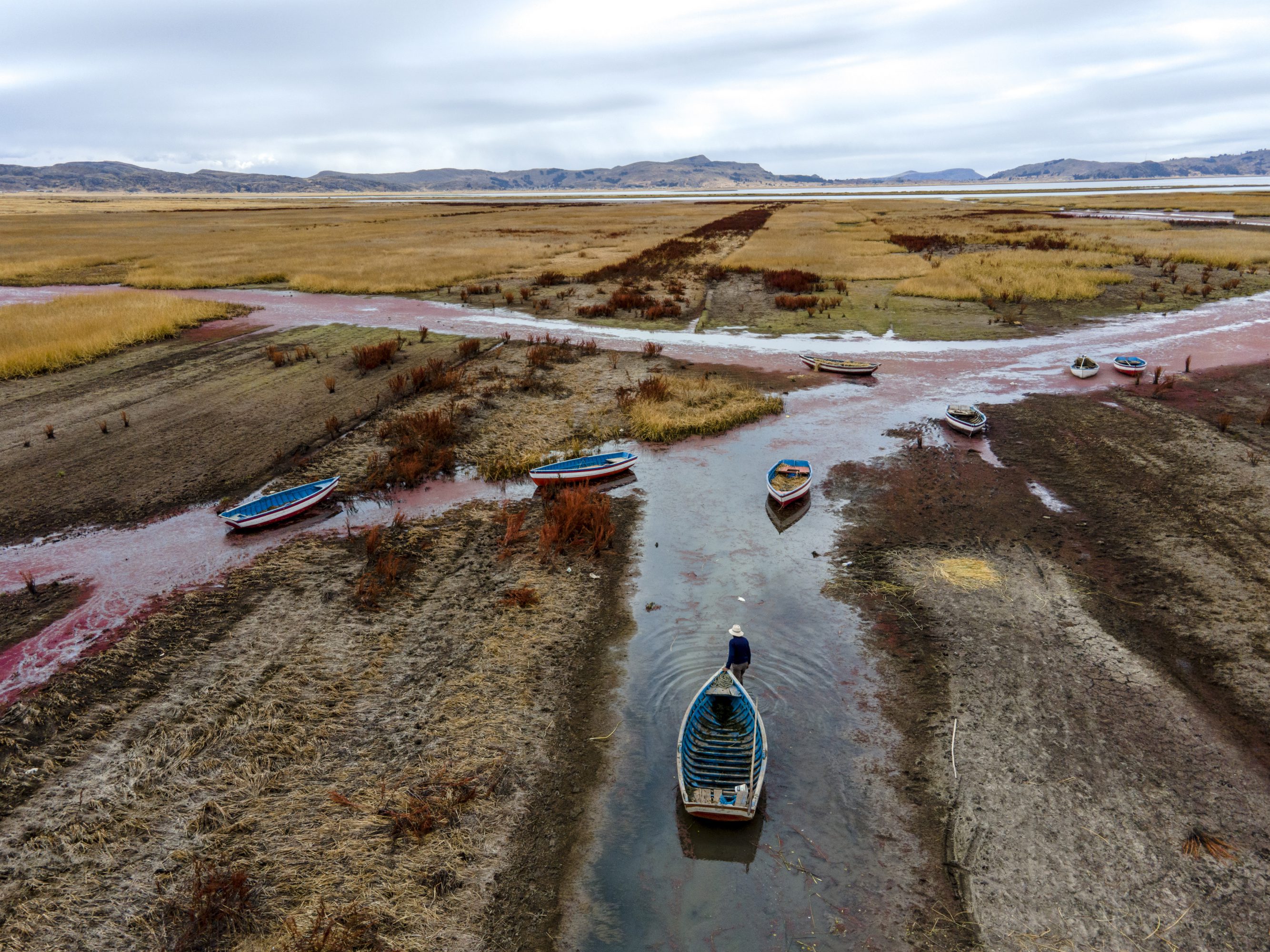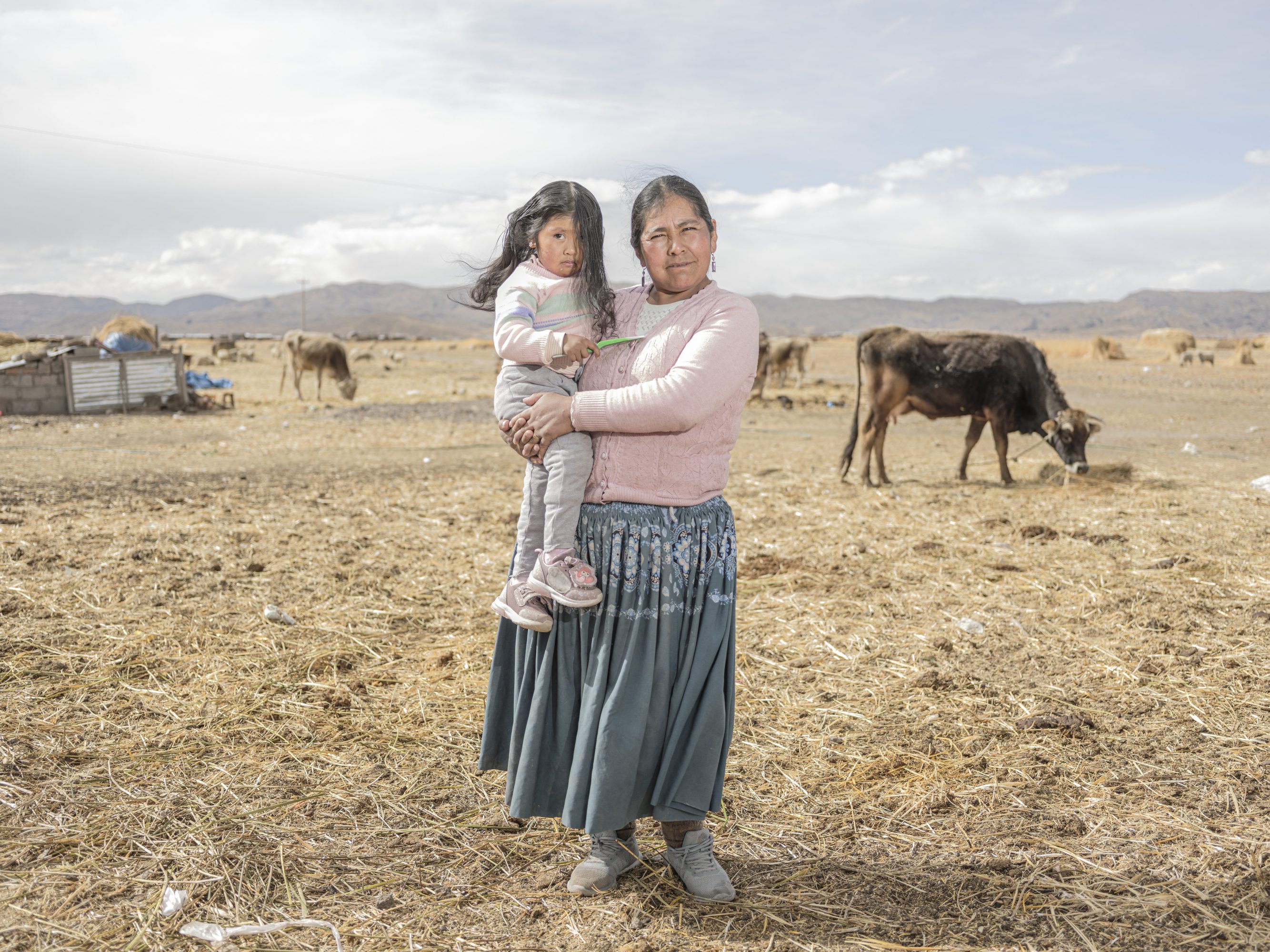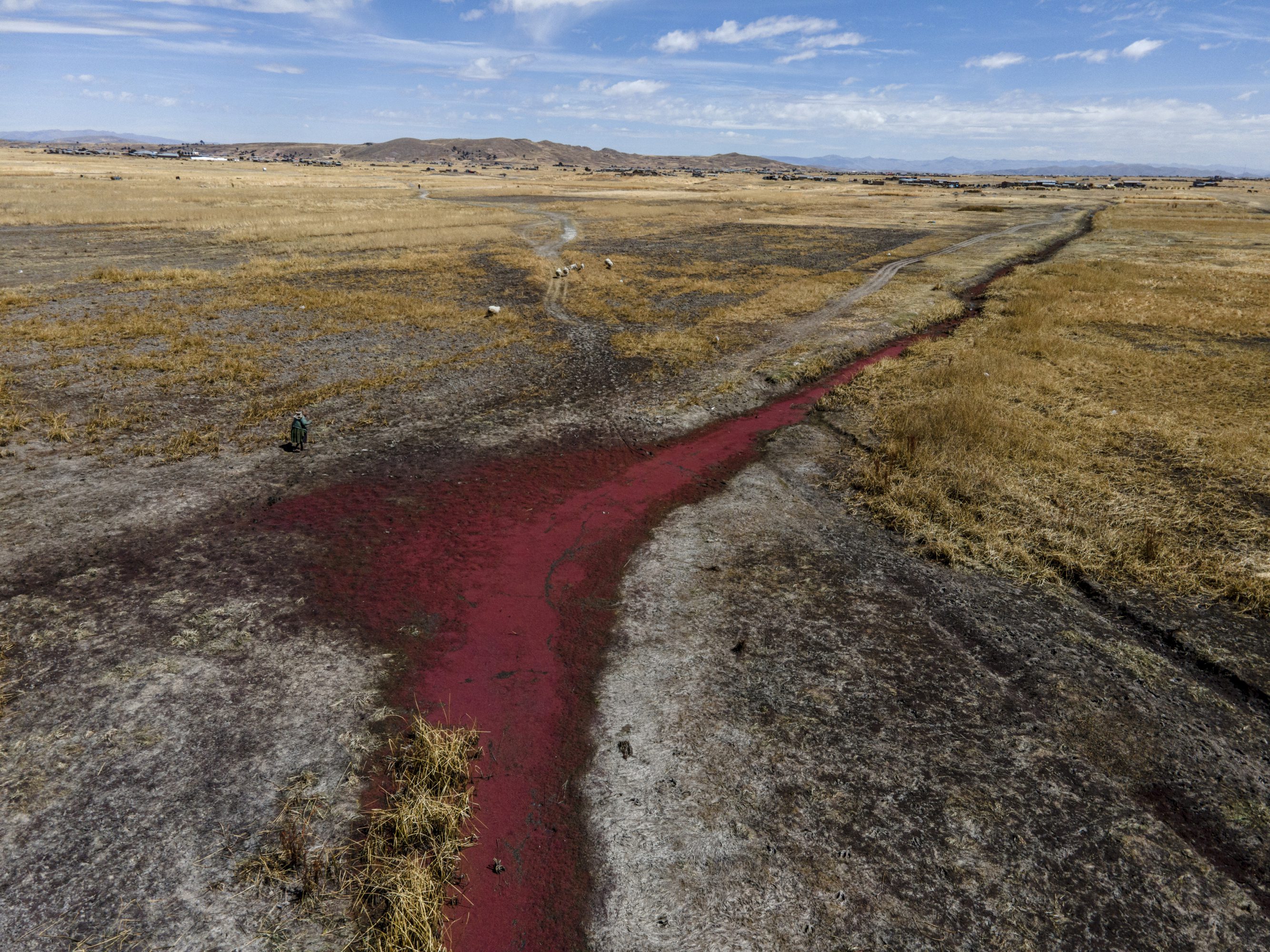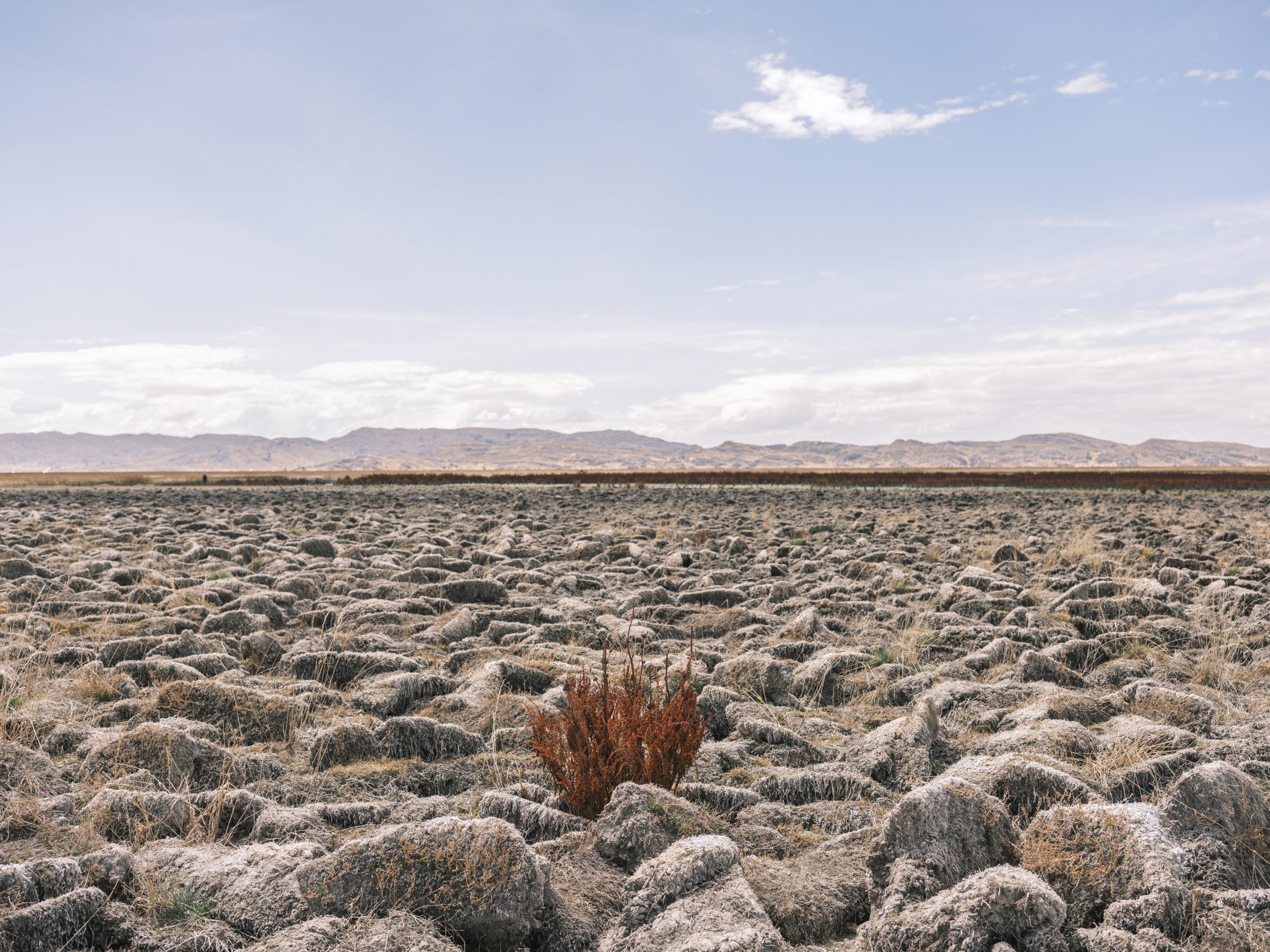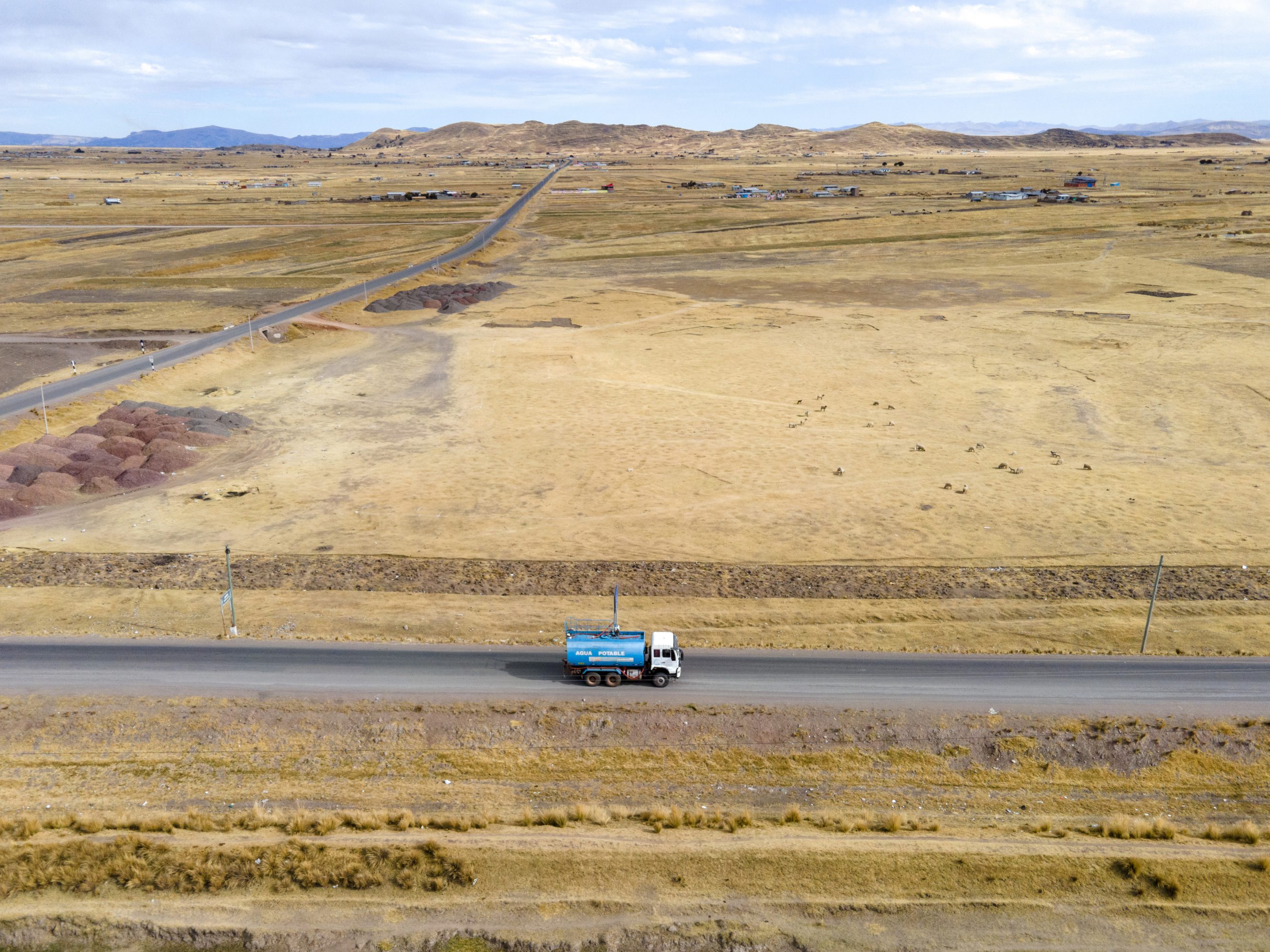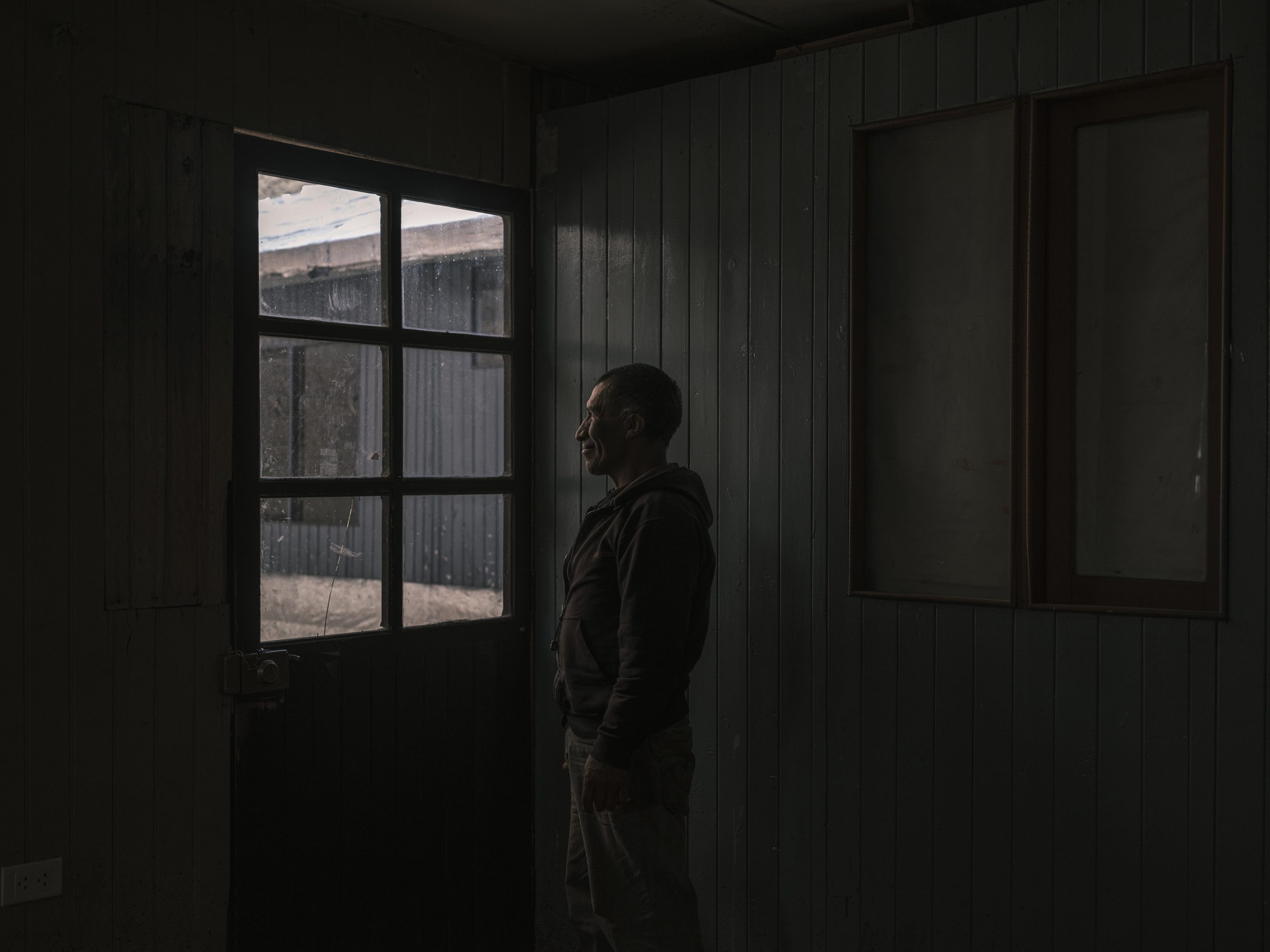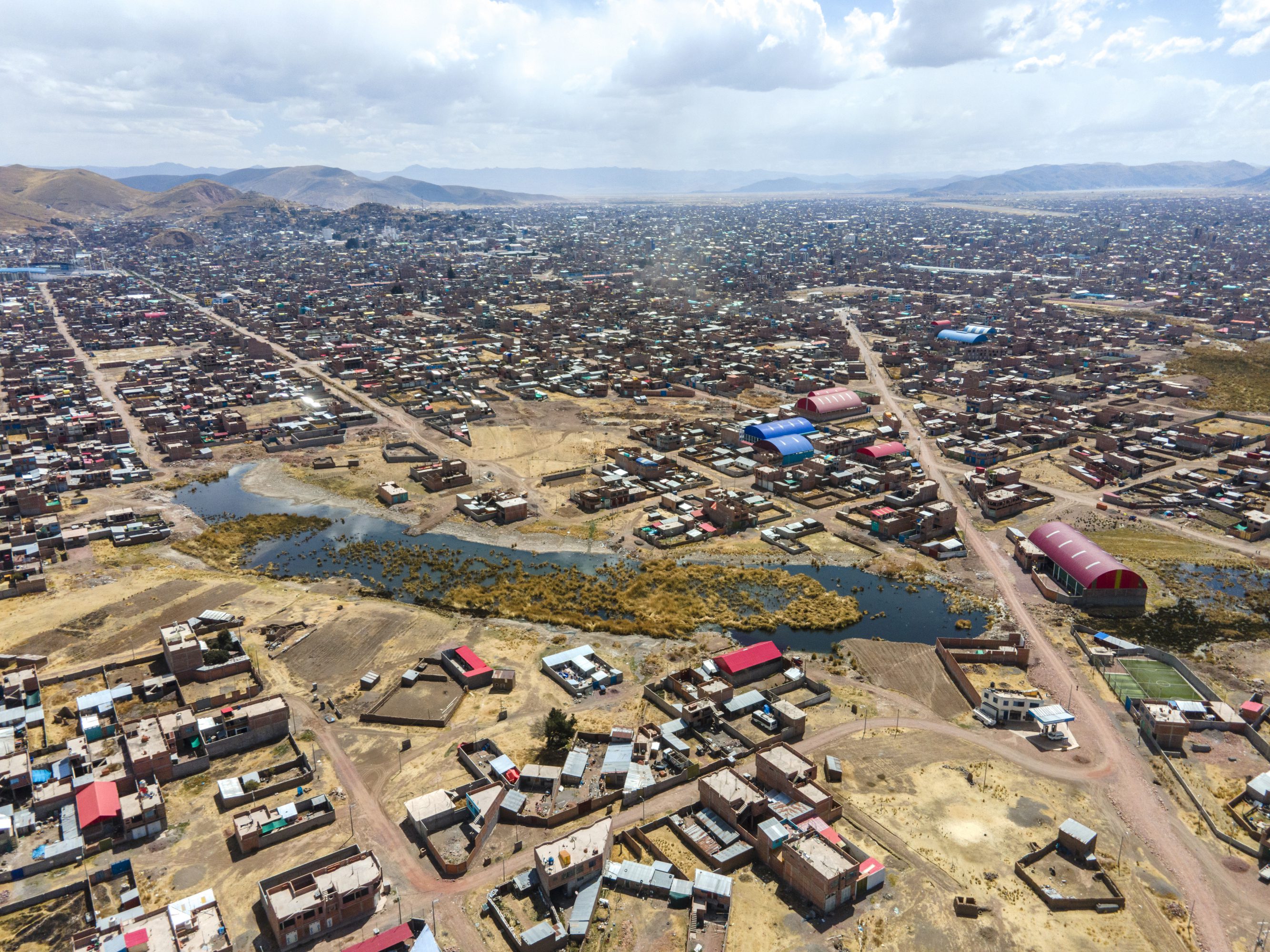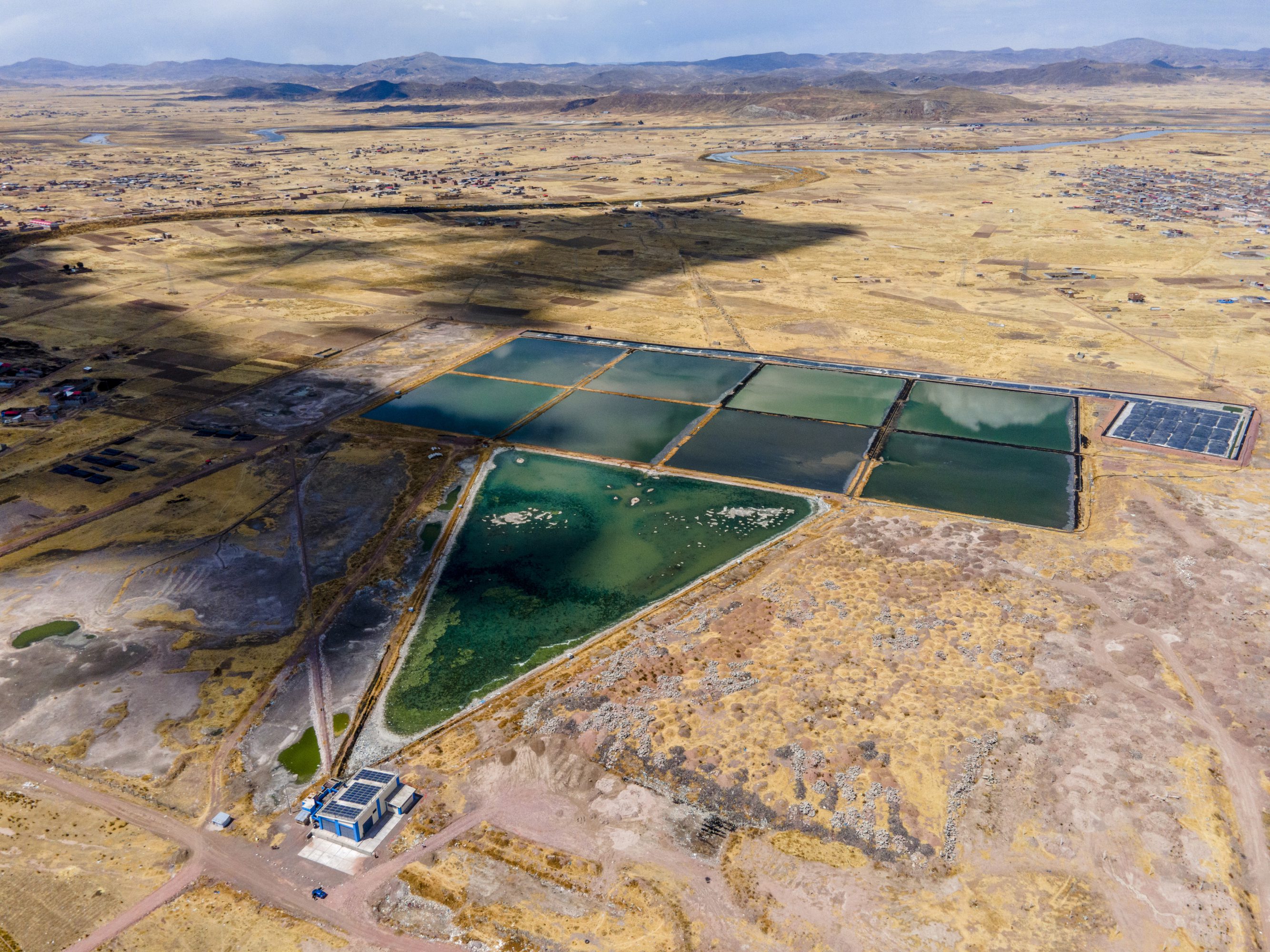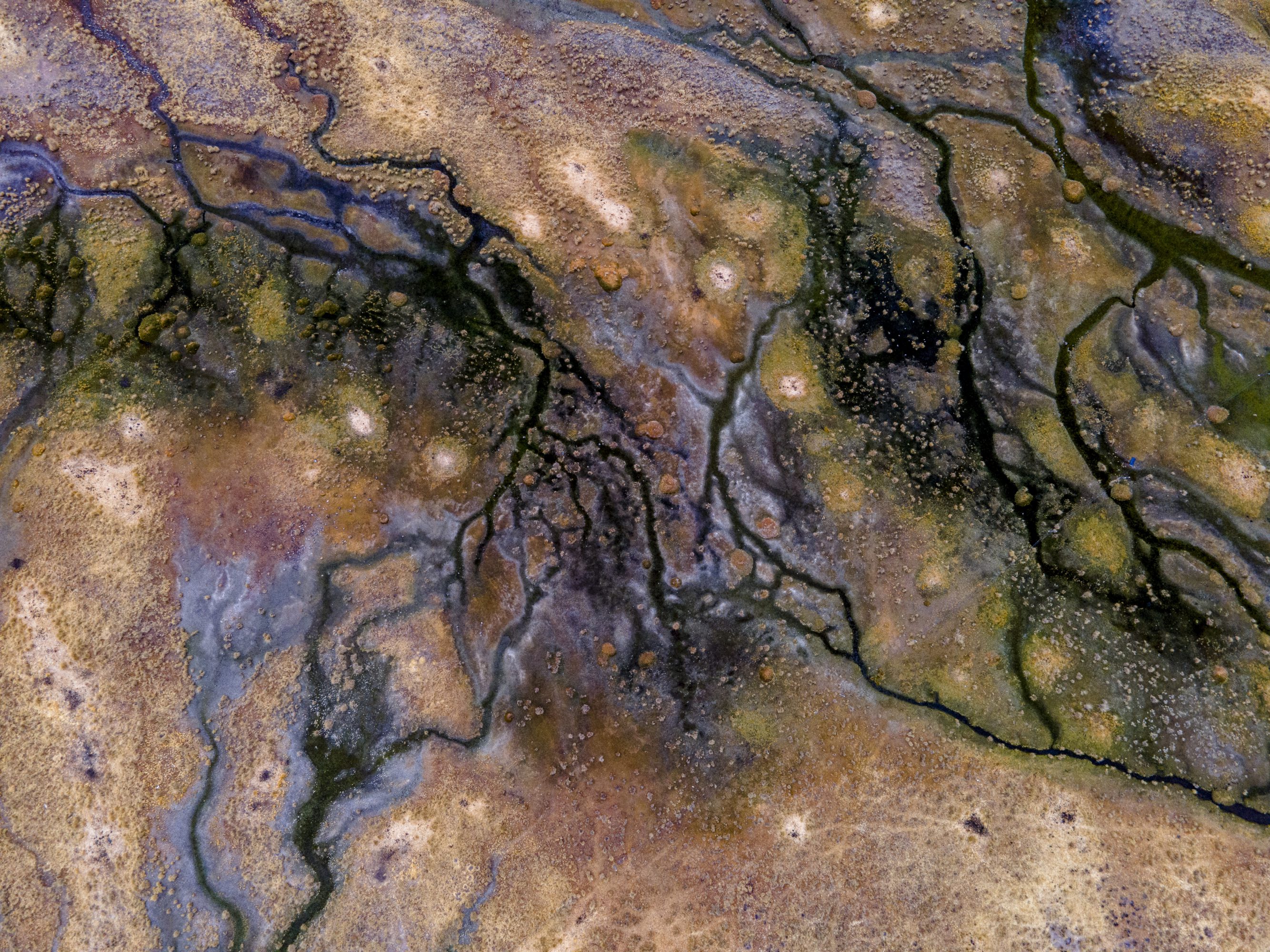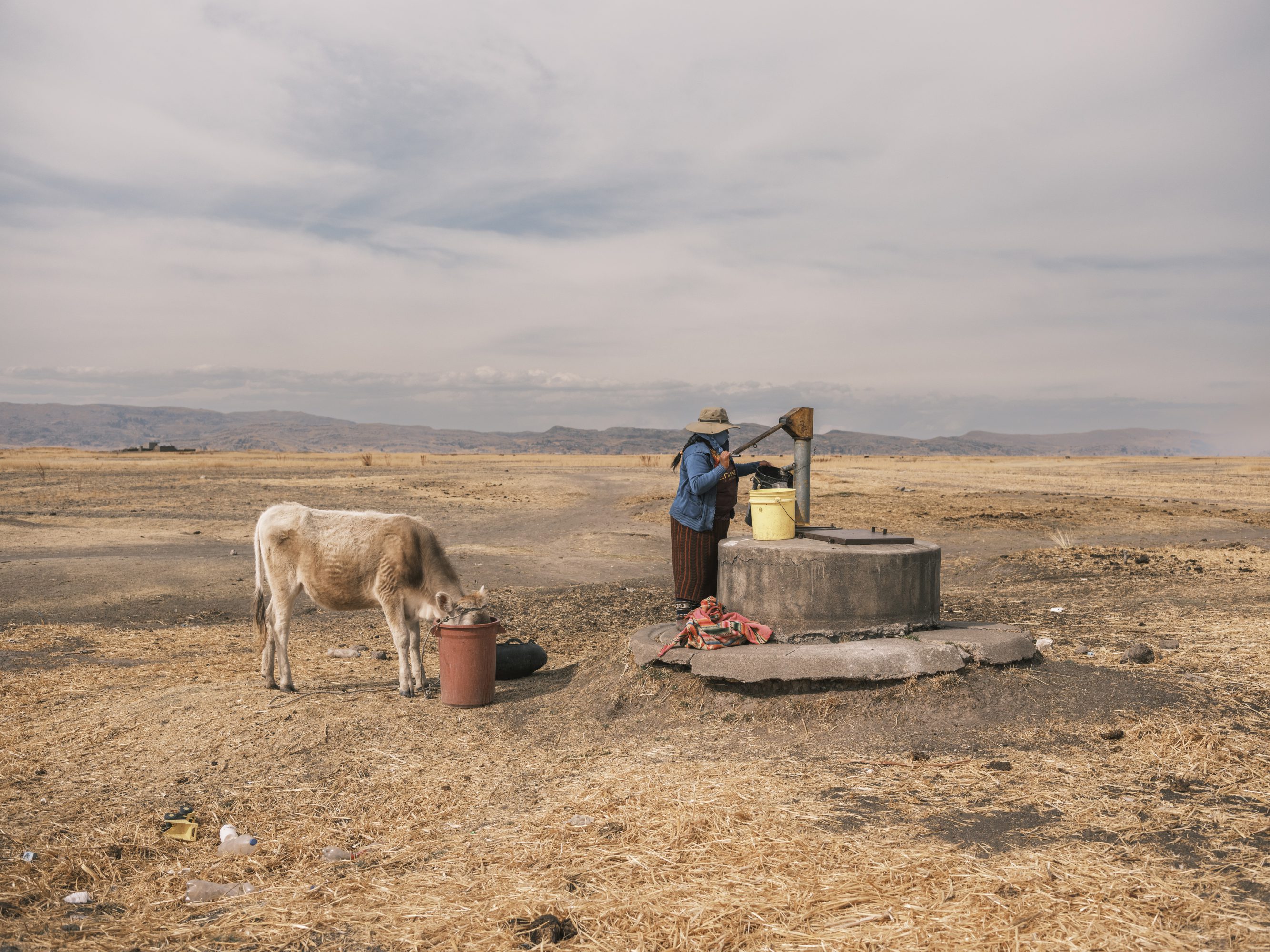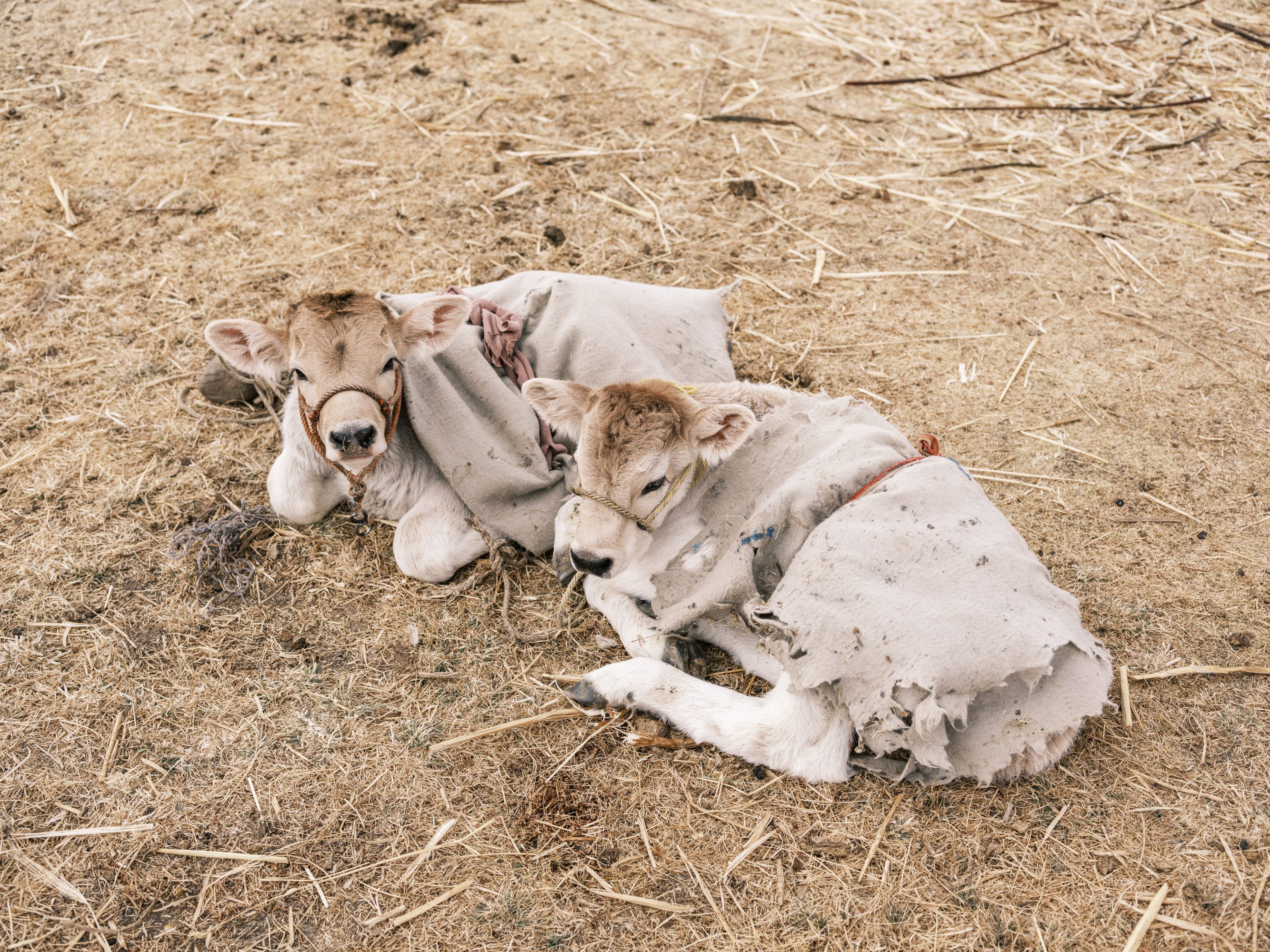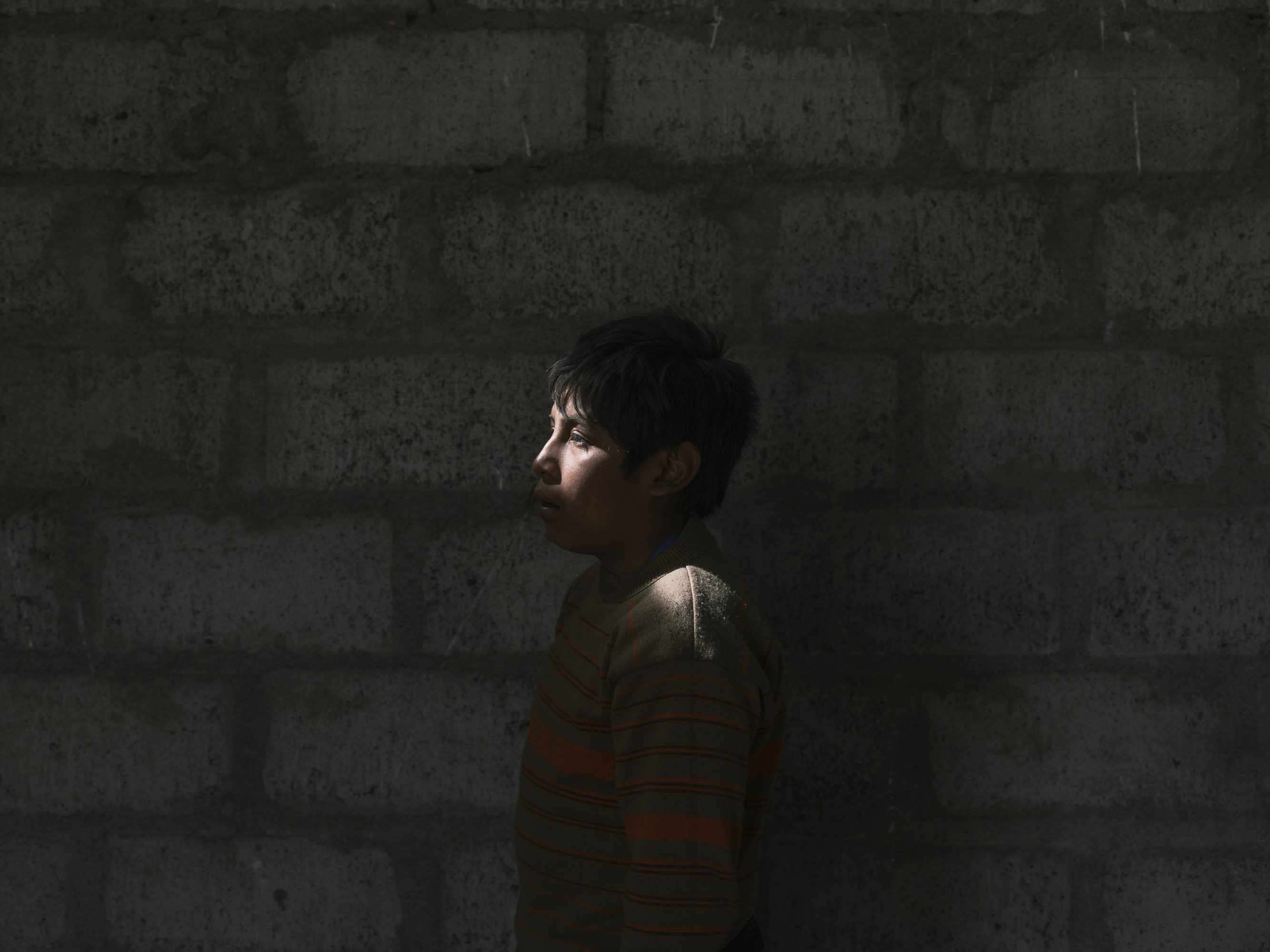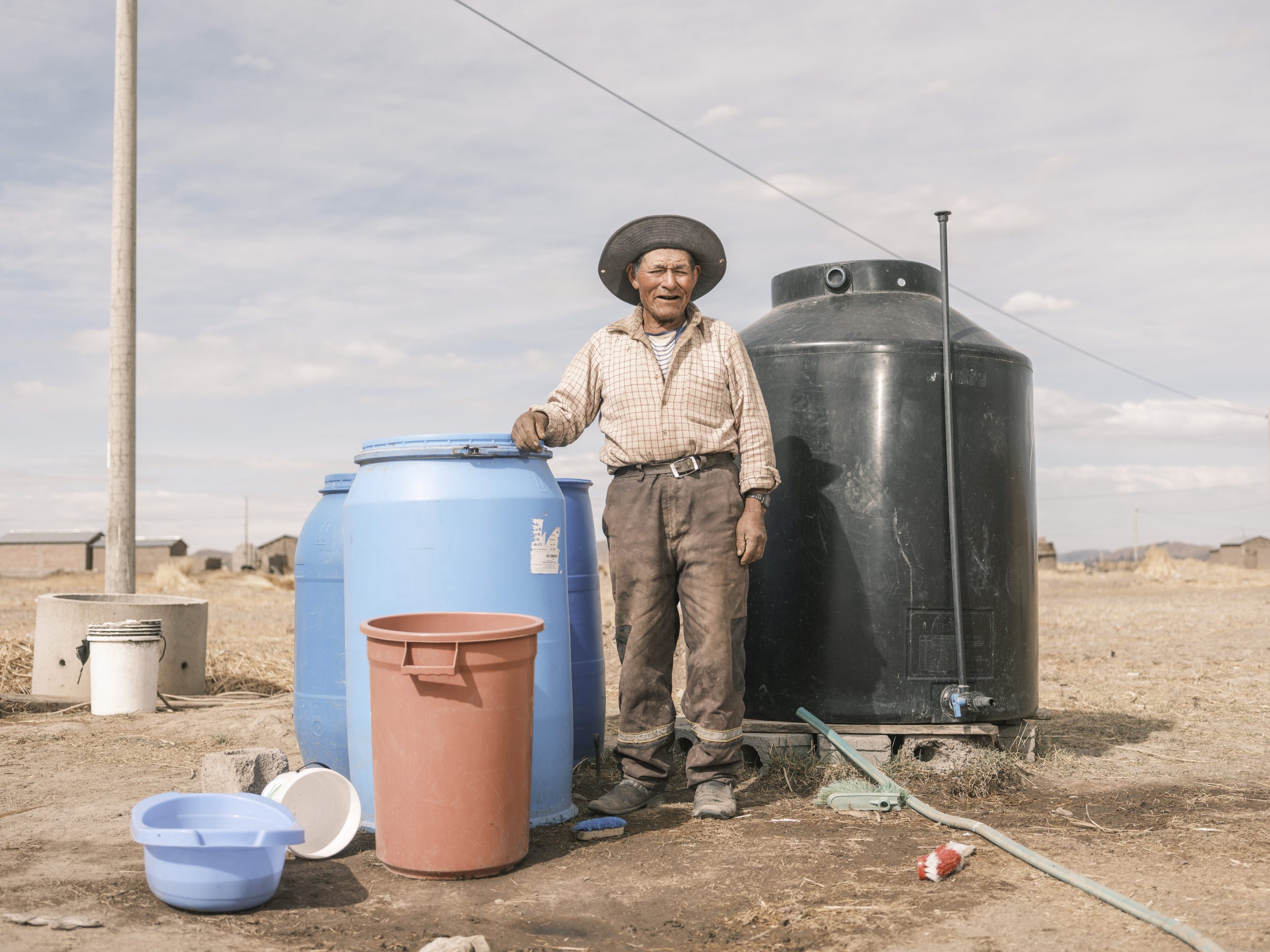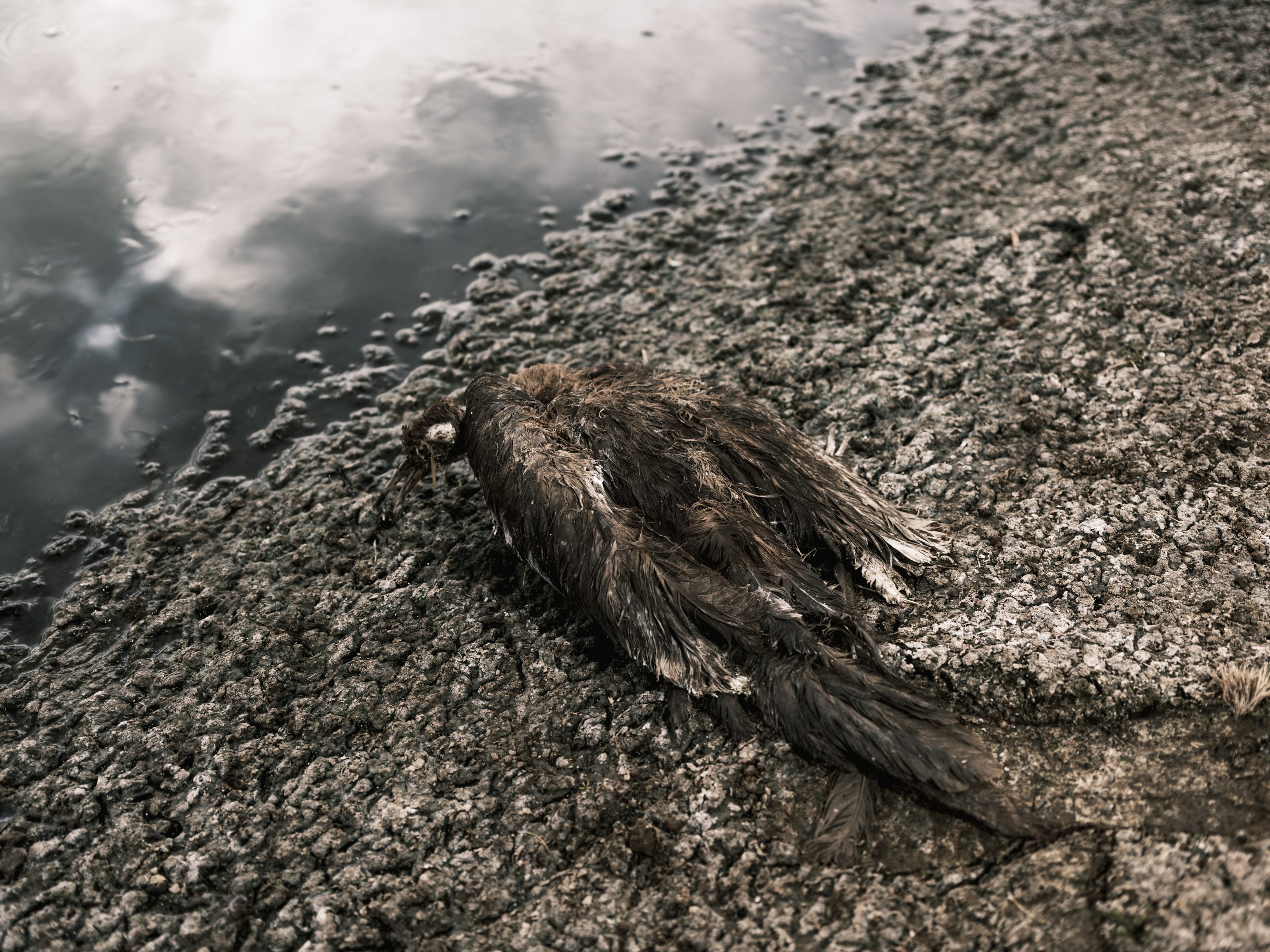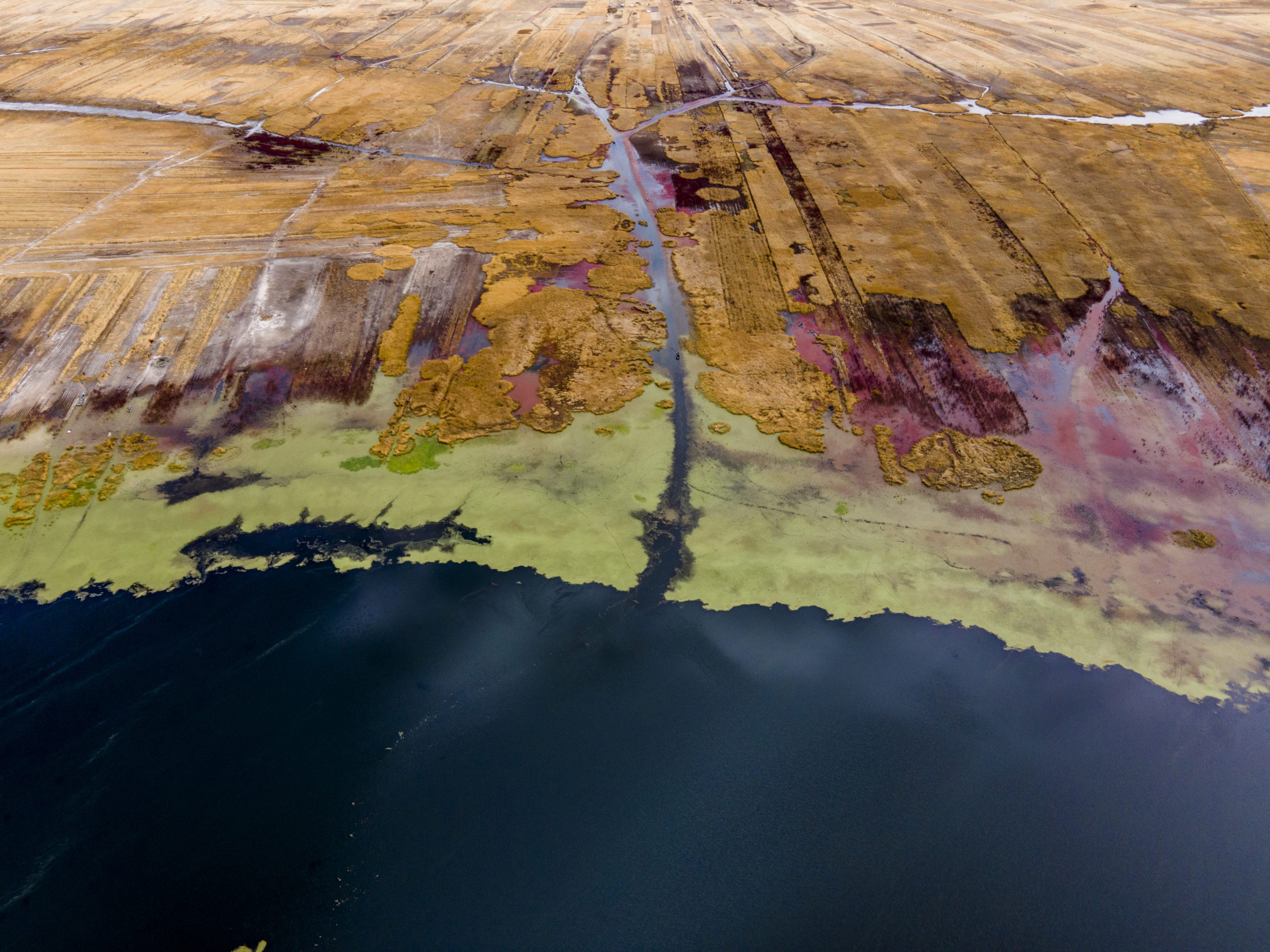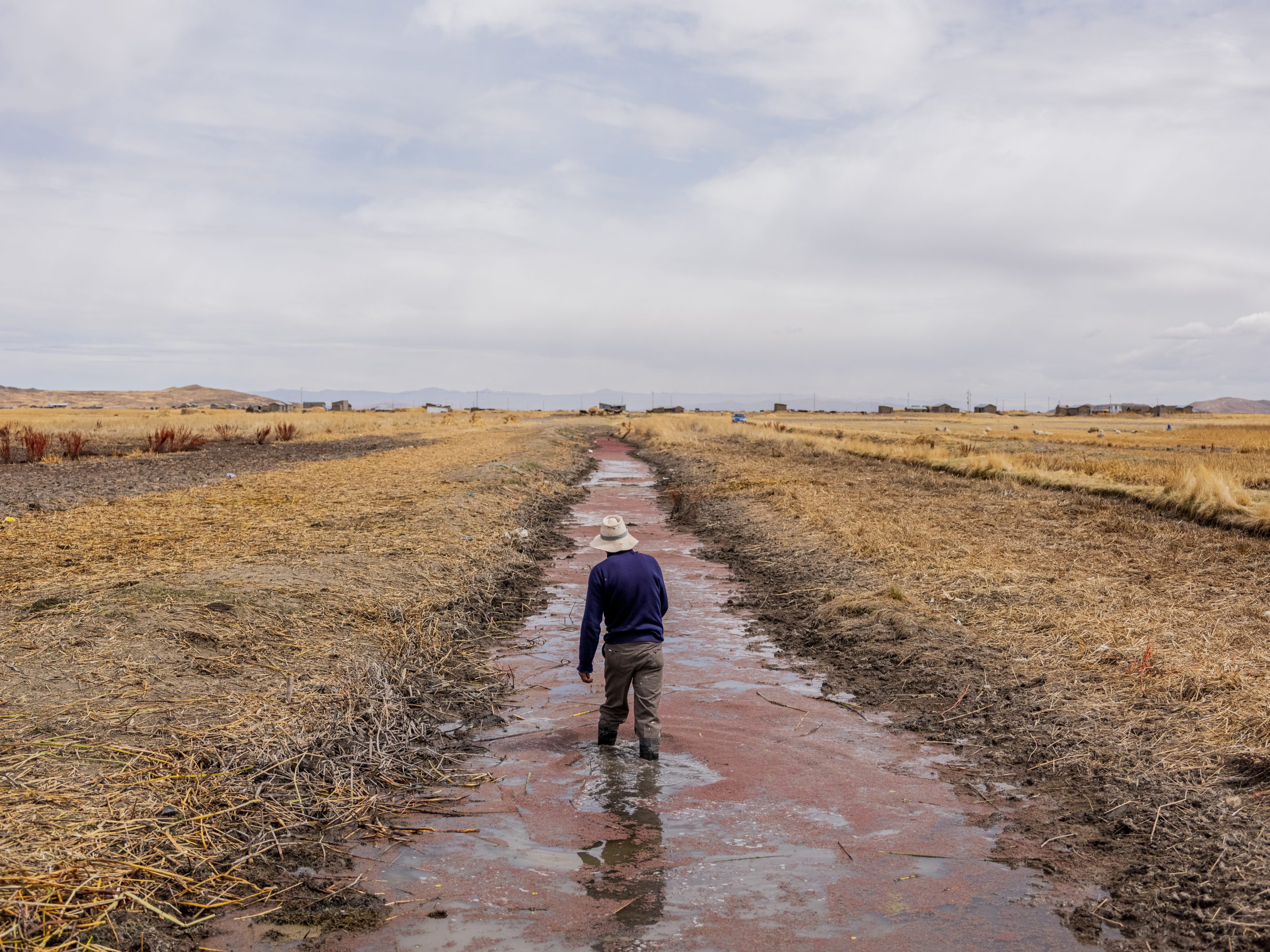“I am sacrificing myself living here. I have to get out," says a 47 year old man, one of the few remaining inhabitants in a community near the town of Coata in Peru on the shores of Lake Titicaca, the highest navigable lake in the world (4000 metres above sea level) and the largest body of freshwater in South America. Now sadly not as fresh as it used to be. Once the sacred lake of the Incas, Titicaca has become a sewer of polluted waters from the drains of 23 cities located around the bay of Puno, made worse by legal and illegal gold mines higher up the rivers feeding the lake dumping a toxic mix of heavy metals into the waters.
Yolanda Flores Montoro, an Aymara environmental activist, sits beside the polluted Hatun Ayllu River which runs into Lake Titicaca, Peru
The Arasi mine, located at the source of the river that runs through the province of Puno and flows into Lake Titicaca, Peru
A farmer shows a handful of salinated soil. The lands the communities used to cultivate in Catata are becoming dry, salty and infertile. Increase in temperatures due to global warming have made it impossible to grow crops in some areas.
Climate change is also impacting on the region. Recent studies indicate that at high altitudes, the effects of global warming are up to twice the global average. The rainy seasons are becoming shorter and more unpredictable, lowering the level of water in the lake and drying out land where crops used to be grown.
The Yanimayo River where its early flow meets with the tailings of the ARASI mining company contaminating the river that crosses the province of Puno until it flows into Lake Titicaca, virtually from its source.Between 2013 and 2019, the Environmental Evaluation and Enforcement Agency (OEFA) conducted a series of environmental impact studies in the areas of influence of the Arasi mining unit. The studies indicate that, at least in 2013, 2016, 2017, and 2019, metals and other contaminants were found above the permissible limits in surface waters, groundwater, and sediments.
The Yanimayo River where its early flow meets with the tailings of the ARASI mining company contaminating the river that crosses the province of Puno until it flows into Lake Titicaca, virtually from its source.
The Coata River during the rainy season. It regularly overflows its banks after passing through the city of Juliaca, where the sanitary landfill and waste treatment plant are no longer able to cope with the effluent produced by the city which ends up in the river before being being dumped into Lake Titicaca.
Although most communities are surrounded by rivers (Peru is eighth on the global list of countries with the most water) they have no access to clean water. In many places the water is now unfit for human and even animal consumption. Farmers have stopped taking cattle to drink water from the river and give them well water instead. This is also contaminated but less so than the rivers. The local rural populations have become reliant on delivery of water by tankers but the deliveries are at best irregular. To avoid sickness many people especially children and the elderly have been forced to migrate from the rural areas to the cities.
Maria Pilinco, who grew up in Huata, decided to leave her town, due to the impossibility of continuing to work the land and the health problems that began to arise due to the lack of water and contamination of drinking water. She moved to Juliaca, the main city in the Peruvian altiplano. The city is experiencing rapid growth as more and more people leave the rural areas forced out by pollution and poisoned water supplies, in turn creating more pollution issues for the city's water system which is unable to withstand the impact of its increased population.
One of the canals in the town of Catata which has been turned red as a result of pollution. The bays of Coata and Catata have begun to be depopulated due to contamination of the water supply.
In Huata the fields where potatoes, wheat, quinoa, and other crops were once cultivated are now infertile and have a high presence of saltpetre and other contaminants.
A government water tanker truck driving towards the community of Coata to deliver drinking water. The water is insufficient to meet the high demand and during the rainy months the roads are impassable often making it impossible to reach Coata and nearby communities. Peru
Mario Huarca (65) from the community of Ocuviri. Huarca says that sometimes he dreams of finding a big fish in a crystalline river, just like when he was a child. Today the entire river basin is polluted. Lake Titicaca, Peru
Aerial view of the city of Juliaca. The collapse of the water treatment plant in Juliaca means that contaminated water is fed straight back into the Coata River via the Torococha tributary. The city, the main urban centre in the Peruvian Altiplano, is experiencing rapid growth as more and more people leave the rural areas forced out by pollution and poisoned water supplies, in turn creating more pollution issues for the city's water system, which is unable to withstand the impact of its increased population, the pollution produced eventually reaches Lake Titicaca. Peru
Aerial of the waste treatment plant in Juliaca. The population has increased so much that the plant can longer process sewage from the town which now enters the river and makes it way down to Lake Titicaca.
Mining tailings in the Torococha River's waters.
A woman pumps water from a well for her cattle. Due to the contamination of the river and lake water, the cattle can now only drink water from wells, which is largely contaminated as well, but less harmful than the river water.
The cattle have started to get sick. The villagers have stopped taking them to drink water from the polluted river and are giving them well water instead. Even this is contaminated, if less so than the river, and their animals are not gaining weight and becoming weak like these two calves who the villagers have put in blankets to help them survive during the cold season.
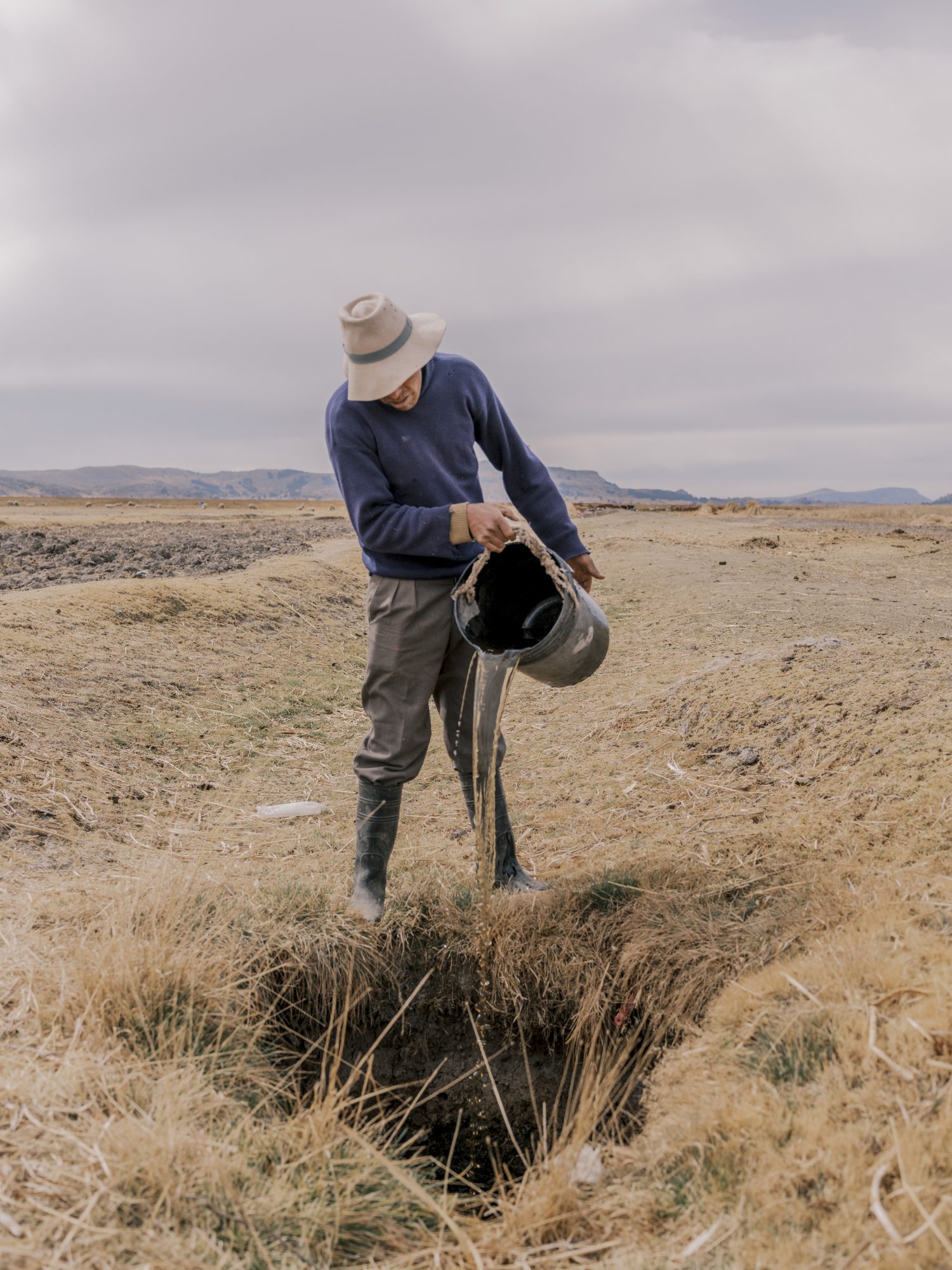
Rufino Coilla (45) pours water from a contaminated water well. According to the National Water Authority's finding all water from the wells in the Coata River basin is polluted. His family migrated to the city, but he stayed behind to take care of the livestock he still owns. Despite this his cattle are constantly sick due to water contamination.
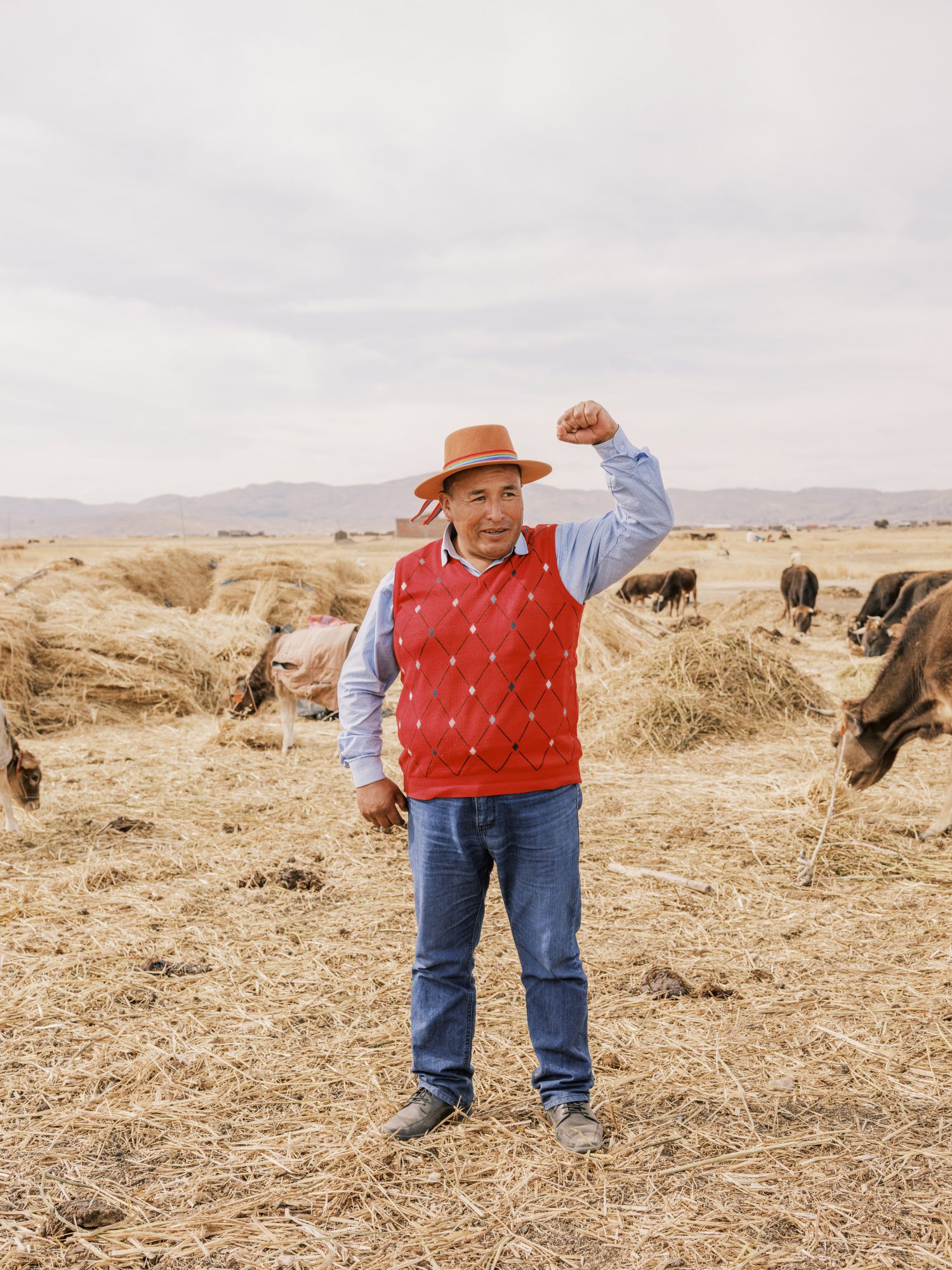
Felix Suasaca Suasaca was born in the community of Coata and has become one of the main leaders and activists representing the communities in the Coata River Basin and Lake Titicaca.
Local activists have started to take action. Felix Suasaca president of the Unified Front against Contamination of the Coata River Basin and Lake Titiccaca has been fighting the state for over ten years organising and mobilising strikes, demonstrations and even blocking the main highway between Puno and Juliacsa. Having been identified as one main organisers of protests he is now targeted by the government.
John Elvia lives in the community of Coata. In this community, a large number of children, according to a 2021 study, have high levels of heavy metals in their blood, causing headaches, growth problems and other consequences.
In Carata a small town near Coata one of the last inhabitants of the lower part of the town recalls, ‘this place used to be wonderful. There were fish, we had our fat animals, there were birds, there were all kinds of things here. There was life and we had a life in this area. But now, because of the pollution, the people are moving to the cities.”
Tiburcio Pilinco Soasacq (75) still lives with his wife Maria, while their daughters and granddaughters have migrated to the city due to health problems caused by water contamination. He says that the water they receive through tanker trucks is insufficient, and sometimes they have to use contaminated well water, which they let settle and purify with bleach.
The Torococha River was a place of passage for a great diversity of birds, today only their carcasses are found. The collapse of the water treatment plant in Juliaca means that contaminated water is fed straight back into the Coata River via the Torococha tributary. The city of Juliaca, the main urban centre in the Peruvian Altiplano, is experiencing rapid growth as more and more people leave the rural areas forced out by pollution and poisoned water supplies, in turn creating more pollution issues for the city's water system which is unable to withstand the impact of its increased population.
Sadly for thousands of inhabitants of the Coata river basin, access to clean water is a distant memory that seems impossible to bring back to reality. “It’s maddening, it’s not just this place that’s bad. Coata, Capachica, the other districts, we have fought, and we have been promised that a day will come. “‘Water is going to be pure’, they have told us but nothing happens,” complains Don Tiburcio Pilinco.
Outflow of the Coata River into Lake Titicaca, one of the most polluted parts of the lake.
Rufino Coila (45) still lives in the Hayllas sector in Coata. He says that his family migrated to the city, but he stayed behind to take care of the livestock he still has. Despite this, he mentions that his cattle are constantly sick due to water contamination. This situation has become evident through the reddish colour of the water.

